Overview
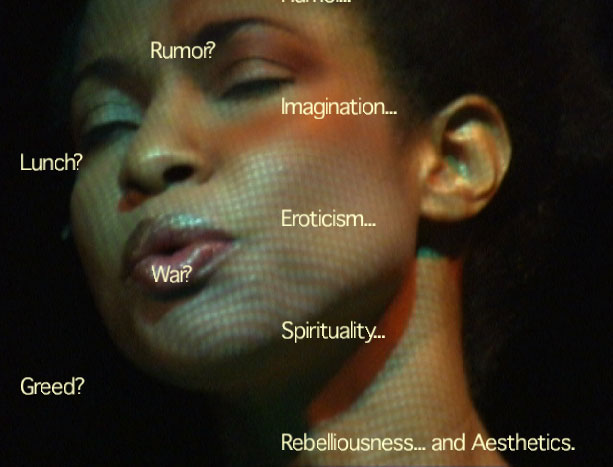
In November 2006, the Baltimore Theatre Project presented the East Coast premiere of Demotic, an hour-long mixed-reality performance work that I conceived and produced with director Robert Allen. Partly improvised, partly scripted, Demotic was intended as a ride through America's political psychoses towards the end of the Bush years, exploring aspects of our experience as they are shaped by Internet and media culture. The dozen individual segments that make up the larger work riff on political corruption, war-mongering, loss by disaster, distraction, and conspiracy mania.
Demotic brought together virtual and physical performers in a collaborative concert merging textual, vocal, and musical improvisation. The creative team included sound artist Maria de los Angeles Esteves, sound artist and programmer Jeff Ridenour, stage performer Tracey A. Leigh, members of the online performance group known as the Plaintext Players (myself, Ursula Endlicher, Lise Patt, Richard Smoley, Heather Wagner, and Ellen Warkentine), and Aida Croal (additional text).
As co-creator of this multi-year project (a sequel to a workshop version produced in 2004), my roles included overseeing custom programming of the online performance environment; directing the online performers in their textual improvisations; serving as an online performer; writing and arranging those sections of the script that were not improvised live; creating the video projections; overseeing all technology.
Telematics
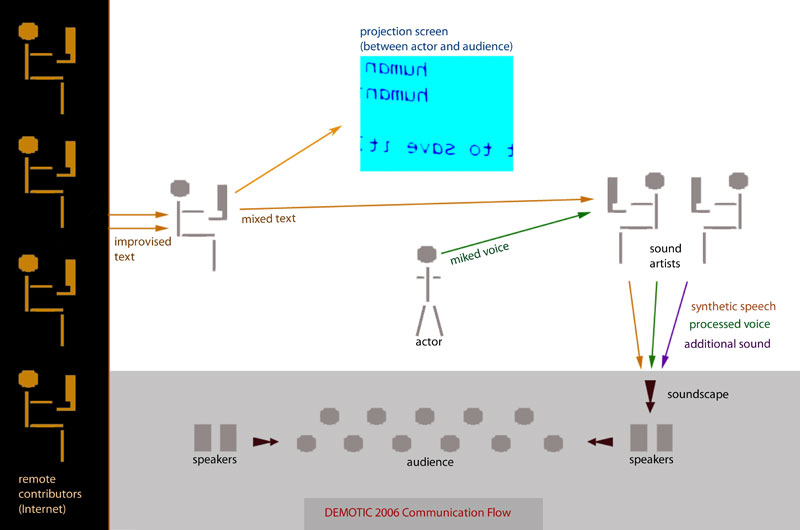
The stage was shared by a single actor and by two sound artists, plus one performer-technician serving as liaison to the virtual performers whose improvised texts formed the basis of each segment. These improvised texts were subjected to on-the-fly processing and custom programming (e.g. semi-randomization functions) and were also sent through a text-to speech synthesizer. The actor's vocal 'readings' of the texts were processed by the sound artists and layered with audio files, MIDI sounds, and the synthetic voices to generate a complex soundscape.
Programming and show controllers
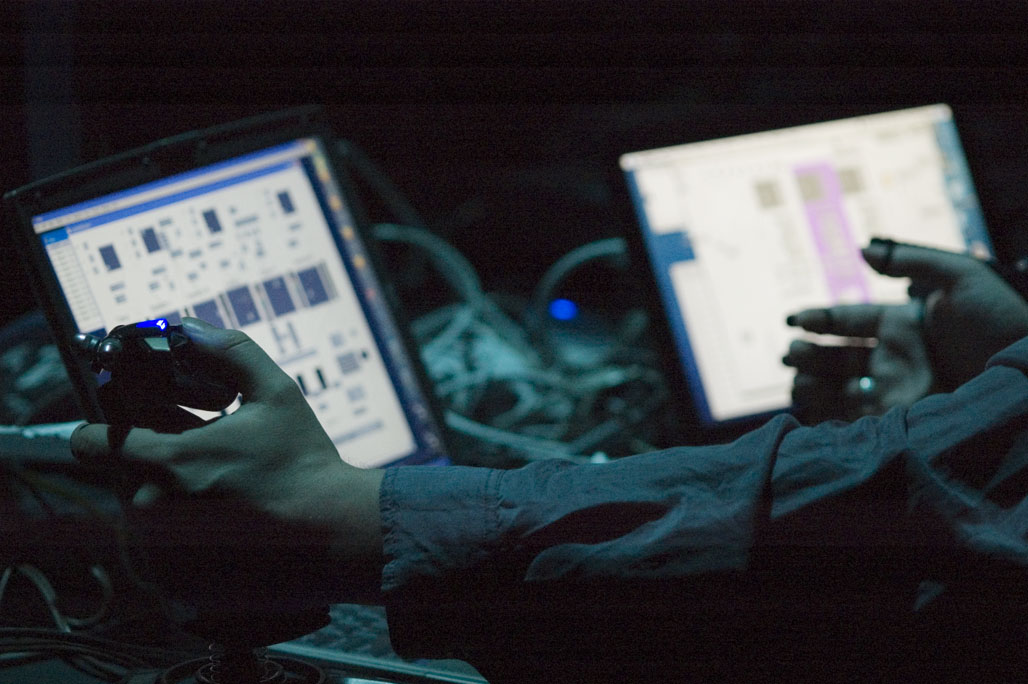
Demotic included a great deal of special-purpose programming using Max/MSP/Jitter to control sound files, to process the actor's miked voice, to generate MIDI sounds, and to handle the speech synthesis of the improvised texts in real time. Programmer Jeff Ridenour extended the built-in functionality of Apple's speech synthesis functions with modules that allowed 6-way spatialization of the synthetic voices, as well as overlayering of different voices.
Ridenour also customized two game controllers—a classic joystick and a data glove—to serve as improvisation control devices for audio aspects of Demotic. These substantially added to the playfully game-like aspects of audio/vocal/textual improvisation that were a central aesthetic feature of Demotic.
Set design

The set for Demotic included two screens hung back to back between the performers and the audience. The stage-side screen served as a scrim for text improvised by online performers or generated through custom programming. This text was performed and processed in various ways by the actor and sound artists.
The audience-side screen was used to project two single-channel videos, one of which ("Distraction") is linked at left. I created the "Distraction" video using text from a prior online improvisation, plus other found materials..
Babbalog
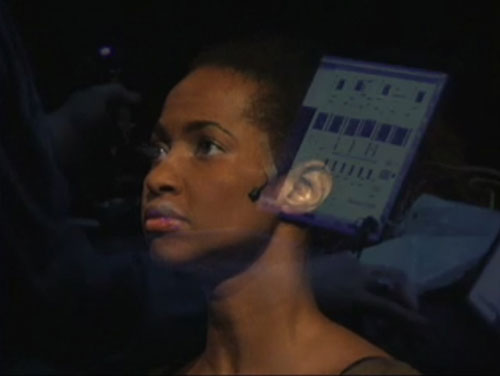
The "Babbalog" segment of Demotic is a largely vocal work hearking back to 2003, when the Columbia space shuttle disaster coincided with the eve of the U.S. invasion of Iraq. It features a text edited from online improvisations, vocal improvisation, sound improvisation, and voice synthesis. A video and a PDF of the text are linked at left.
"Babbalog" (video excerpt, 3:01 min.)
Gnosis
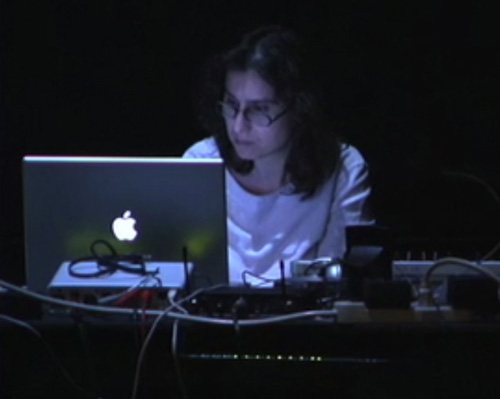
"Gnosis" is a poetic credo featuring vocal and sound improvisation and music by Maria Esteves. The text I wrote incorporates lines from a 1st century A.D. Gnostic poem ("Thunder, Perfect Mind") and found Internet material.
"Gnosis" (video, 4:24 min.)
Text of "Gnosis" (pdf)
Scherzo
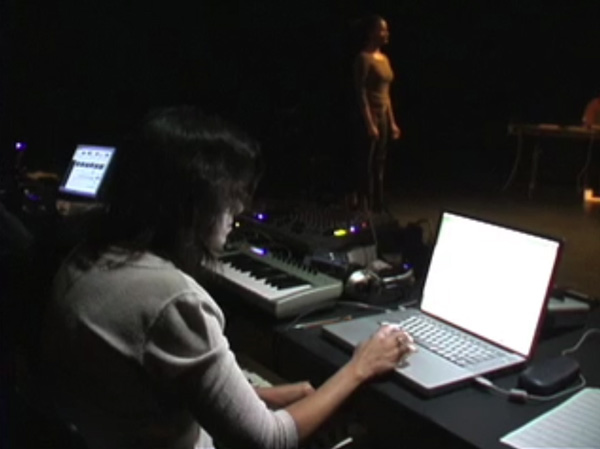
"Scherzo" is a poem about fear and ruin by fire that is designed to be performed at the eponymous tempo, accompanied by sound improvisation.
"Scherzo" (video, 1:00 min.)
Text of "Scherzo" (pdf)